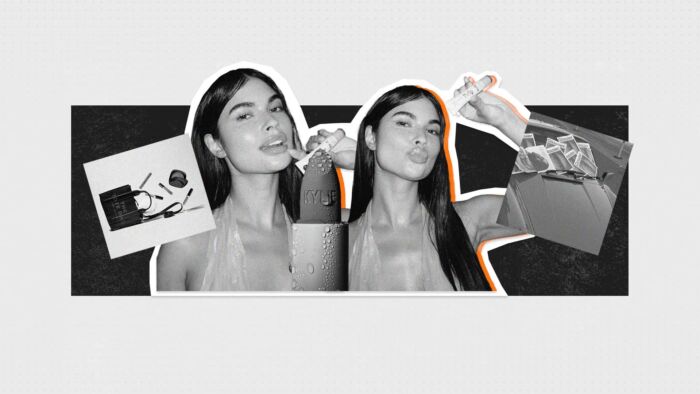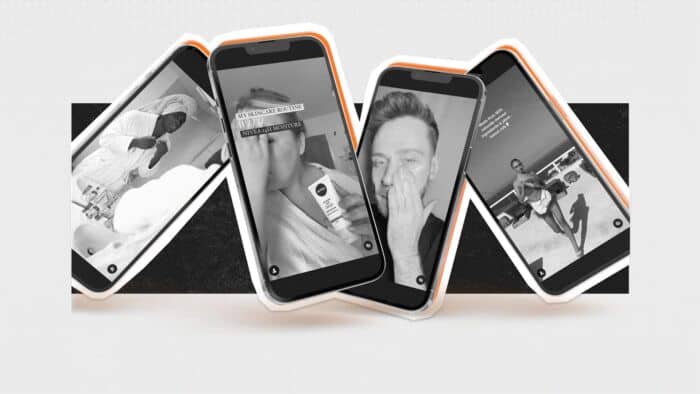Beauty is fast becoming the poster child of social media marketing. Grossing over $617bn in 2023, the sector is predicted to grow by a further 9% in 2024.
Video-led social platforms like Instagram and TikTok are becoming an increasingly dominant engine of this growth, taking brand awareness to the next level and driving a constantly cresting wave of trending products.
- Beauty and care ecommerce sales topped $42bn in 2023, from $23.7bn in 2018.
- More than 1/3 of Americans who follow beauty influencers will check their content for recommendations before buying.
- 3/5 of UK consumers regard the social media personality they follow is an expert on the topic they cover.
Riding this wave in great style is a growing community of skincare and beauty influencers: ranging from global superstars to home-grown social media celebrities, they’re quite literally the new face of the beauty industry.

Instagram, the original home of beauty social marketing
While TikTok tends to catch more headlines due to the clickability or controversy of the latest Gen Zalpha beauty trends, Instagram is a time-tested and reliable powerhouse for beauty marketing that you’d be brave to ignore.
In many ways, Instagram pioneered the contemporary beauty social marketing scene of today. The platform set itself apart from other social media platforms through the 2010s, with a focus on aesthetics and media-over-text which lay the perfect foundations for beauty influencers.
Like other leading social apps in 2024, it’s grown into a powerful instrument for promoting brands through authentic content and the broadcasting of trusted, personal opinions. Instagram has kept up with the times, adding features like Reels to make a home for the ultra-fast, video-led scrollability that audiences and marketers love.
What makes Instagram different?
Unlike TikTok, which is a lean, mean viral trend machine, Instagram still retains static posts and isn’t as prone to being the source of the latest headline-grabbing trend. Yet for many marketers, it’s an essential choice. Why?
The primary reason for the co-existence of these two social behemoths is the split in the age demographics that they target. TikTok is the overwhelming app of choice for Gen Z downwards, while Instagram is the home of some Zillennials, most Millennials, and a significant proportion of the older generations.
As a result, if you want to talk to those older audiences, you need to be on Instagram. But – before you go rushing off, make sure to bear in mind the reasons why these older beauty-oriented audiences are on Instagram, and what you need to do in order to engage with them effectively.
People they can relate to
Users go on Instagram to interact with people that parallel their own lifestyle and personal characteristics. Your influencers need to reflect that, which means a generally higher age range, and a breadth of ethnicities and body types.
A polished aesthetic
As a more ‘mature’ social community, you generally won’t find dances, challenges and other hallmarks of TikTok here.
Beauty content, in particular, is more likely to have a clean and wholesome aesthetic, and often speaks to how it links to health, lifestyle and sustainability as well as effect on appearance.
Established influencer personas
Fundamentally, Instagram has been doing beauty and wellness for longer than TikTok. That means there’s longer-lived, well-settled influencers who have built their home and followings on Instagram.
Let’s explore a few of the best brands and what they’re doing to achieve the kind of excellent results we’re talking about:
1. Revolution Beauty
Revolution Beauty partnered with a range of influencers, from @elizabethkayeturner (500K followers) to Elise Morgan (68.8K followers), targeting a range of audience sizes to promote their new Bronzing Drops products.
Content was centred around close up demonstrations of the product, showing before and after looks in combination with the influencers’ regular makeup routines.
This also gave influencers the opportunity to explain what they loved about the product, along with tips on how to get it to work at its best.
The before and after video is a selling method as old as time, and it’s clear why – in the hands of these skilled individuals, the Bronzing Drops contributed to some fantastic looks. Crucially, seeing the influencers pre-makeup also made them so much more relatable to everyday audiences, helping audiences see the results that they could share in.
The power in this approach is that viewers can quickly get a full understanding of exactly how the product works and how they can fit it into their existing beauty routine, addressing potential customer objections from the start.
The positive influencer commentary is backed up in real time by the visible results, with the overall experience running parallel to that of having a product recommended to you by a friend. The content is casual, filmed on phones in bathrooms or bedrooms, giving the viewer that sense that they’ve been welcomed in to that influencer’s life and are getting truly authentic advice.
2. Glossier
Glossier has mastered the art of community on Instagram. With that comes plenty of UGC (user-generated content). Their followers have become a mighty sales tool, with fans posting about the brand’s products. Glossier encourage this activity by reposting the content to their feed and collaborating with influencers as well.
With 2.9 million followers and a calming feed, Glossier is killing it on Instagram. Their aesthetic and tone of voice stay consistent throughout the channel with a push for calming visuals that showcase their products. They create content in batches, with each set of posts focusing on a different product.
The most important element to take away from their profile? Authenticity. Every part of the brand’s social media efforts is based on authentic, real, and relatable content. You can tell they don’t use filters and celebrate beauty in all forms. Combine that with real customer posts, and you get some seriously potent social media marketing.
3. Nivea
Nivea understands that beauty products are often best promoted outside the strict confines of beauty influencers and models, by bringing them into the everyday where their customers live.
For their Luminous630 Anti-Stretch Mark Body Oil Serum, Nivea selected influencers from among parenting creators. These included Only Way is Cheshire star @rachellugo1 (313K followers), who creates a range of fashion, lifestyle and parenting content, and @charltaylor (57.8K followers), with her focus on being a mother, mental health, interior design and food.
They also engaged across other verticals for their wider product range, including footballer @emansv2 (191K followers) for their deodorants, to travel creator @loulouexplores who promoted their lip balm by showing how well adapted it is for snow sports.
Almost everybody in the world uses skincare and beauty products in some shape or form. Nivea recognised that only a fraction of that customer population actively seeks out beauty content.
While those individuals aren’t following beauty influencers, they are following sports, parenting, travel and food influencers. By finding organic crossover points between those interests and their products, they’re able to convincingly showcase the benefits of buying Nivea to an incredibly broad and diverse audience.
And, like all influencer marketing, being able to demonstrate the product working in an authentic, real-world setting, through a trusted persona, is a recipe for success.
4. L’Oréal Paris
L’Oréal Paris have over 10.7 million followers on their Instagram and it is clear to see why. When it comes to dominating Instagram in the realm of beauty and cosmetics, L’Oreal Paris is a true heavyweight. With a strategic approach that combines the use of diverse influencers, a balanced product showcase, and an educational element, they have cultivated a substantial following and maintained a strong brand presence.
L’Oreal Paris, in the realm of Instagram beauty accounts, has mastered the art of influencer collaboration. Their approach seamlessly blends the star power of celebrities like Eva Longoria and Camila Cabello with the authenticity of grassroots influencers who offer product usage tips. This diverse mix allows them to showcase a wide range of products and connect with a broad audience.
These influencer collaborations also help them achieve balance in presenting its extensive product lineup by creating a consistent theme to posts even if the products vary. From men’s grooming to haircare and makeup, their Instagram feed ensures that every product category gets its moment in the spotlight. This strategic equilibrium highlights the importance of a comprehensive product showcase, catering to a diverse audience with varied interests.
But what really stands out their use of Instagram as a platform for education and societal engagement. Their “Stand Up against Street Harassment” campaign showcases their commitment to meaningful causes, adding depth to their brand identity. This approach underscores the value of using Instagram not just for sales but also for genuine engagement with your audience on topics of importance.
These beauty brands already have a platform their celebrity founder has built. But how are they growing on social and keeping their customers engaged? These companies show us how it’s done.
5. Fenty
Global superstar, Rihanna’s beauty brand Fenty, dominates the beauty niche on Instagram. When they started the company back in 2017, they had a simple and clear message. A post on their feed from Rihanna herself explains:
“Fenty Beauty was created for everyone: for women of all shades, personalities, attitudes, cultures, and races. I want everyone to feel included. That’s the real reason I made this line.”
What has grown from this sentiment is an engaged, thriving and growing online community that show up time and time again.
Community can be powerful. When you have an engaged comments section and an interactive profile, your followers will keep coming back. Often brands can focus on top-of-the-funnel marketing, looking at how to increase brand awareness (this is definitely the case with influencer marketing). But social media channels like Instagram can be utilized in different ways to hit your targets. 66% of brand community members say they are loyal to the brand, so encouraging your fans to engage with you and each other can really pay off.
Fenty replies to comments on the regular and keeps the conversation going, addressing concerns and speaking directly to consumers. If you do the same, you’ll start reaping the rewards of an active, engaged community.
6. CeraVe
CeraVe have carved a place out for themselves in the beauty scene this year by breaking the mould when it comes to ads and influencer content.
For the most famous tier of adverts on Earth, Super Bowl halftime, they got everyone talking with a tongue-in-cheek ad starring Michael Cera as the fictional genius behind CeraVe, playfully making satire out of the classic, breathy and dreamlike style of beauty adverts. You can dive deeper into our insights on these world-famous adverts in our dedicated Super Bowl ad analysis.
Back on Instagram, they’ve been working with a range of influencers, from beauty enthusiasts to parents and dermatologists. The key to this campaign was giving them free reign to crack jokes and express their authentic selves while exploring the benefits of the CeraVe range.
From the adorable dad jokes of @chowjiahui (88.5K followers) and uplifting pep of entertainer @almost.cesca (591K followers), to wholesome mother and physiotherapist content from @rie_defined (230K followers), there’s a rich diversity of positive content here.
What’s consistent here is personality, positivity and – of course – the product. CeraVe fully understood the assignment that social media marketing needs to be fun, and as a result, they’ve given their brand a shining halo that’s sure to translate into positive results.
7. Elf Cosmetics
Elf Cosmetics took the concept of transplanting beauty marketing into other, related verticals and refined it, tightly targeting an event-specific audience within fitness and building a marketing crescendo around that single event.
They went all in on the London Marathon, which sees over 50,000 runners hit the city in a single event.
Elf created the E.L.F. Run Club, championed by running influencers like @misha_grimes (183K), to promote their Power Grip Dewy Setting Spray. Their influencer content included BTS footage of the run club and the race itself, plus pre-run makeup routine content from the likes of @chloeandcosmetics (669K followers).
Running the London Marathon has increasingly become a status symbol for lifestyle and fitness focused individuals in recent years. More than ever, runners want to look their absolute best despite intense physical exertion, making it the ideal opportunity to demonstrate how the E.L.F. Power Grip Dewey Setting Spray can make that happen.
By creating the E.L.F. Run Club, the brand was able to create an immersive in-person experience for a large number of runners who could join up before the event, creating an authentic connection to the brand and its products which crossed the digital-physical boundary.
Being able to showcase this network and the products that underly it, through a hybrid approach based around a real-world network supported by influencer content, allows E.L.F. to build customer loyalty in a way that a purely digital approach never could.
8. Dove
Dove brought inclusivity and diversity to the forefront of their recent Instagram influencer campaign, and like some other brands we’ve covered here, targeted sport and fitness verticals in addition to traditional skincare and cosmetic influencers.
It was a natural choice to work with popular fitness influencers like @sanfrankrisco (125K followers) to promote their deodorant range, as well as @sophjbutler (135K), who brings a focus on body and disability positivity to her fitness content.
That’s in addition to dermatologist @dr.fab (120K followers) who brought a more science and health focused approach to explaining how to use Dove deodorant to effectively manage perspiration and body odour.
Dove applied several methods to communicate the benefits of Dove deodorant to their audiences.
By working with fitness influencers, the brand was able to integrate themselves into the inspirational content users typically find on these channels. By linking themselves to user aspirations, and imagery of fitness success, Dove positioned themselves as the brand that springs to mind for fitness fans who want an antiperspirant that supports their goals.
And though it’s a deodorant, partnering with dermatology influencers like @dr.fab allows Dove to tap into a parallel audience that’s likely to be primed for antiperspirant purchases; users who are looking to improve their skincare routine are likely to want to feel liberated and in control of their body odour, too.
9. Gucci Beauty
With luxury at its core, Gucci Beauty promotes more than just products on its Instagram page, it sells a lifestyle. From its artistically beautiful video campaigns to collaborations with talented creatives, Gucci Beauty build an eclectic feed that’s worth scrolling through.
Luxury brands have the tough job of needing to stay in touch with their audiences through genuine, real-looking content and keeping up appearances with high end visuals and sophistication. How can you strike the right balance? By partnering with the right talent and allowing them to share original stories. Creators should be allowed to create. They have a following for a reason, so when you decide to partner with someone, let them do the talking. Gucci interview their ambassadors and provide a platform for them to share their stories and personality. In return they drive massive engagement and build trust with their customers.
10. Chanel Beauty
Chanel’s content just got funner. When you scroll through Chanel Beauty’s Instagram reels you find small snippets of models and other influencers opening a locker, fridge or other door to find one of Chanel’s products. This provided quirky and fun entertainment for viewers whilst still retaining its luxury aspect.
A comment on one of these model-led videos stated: “Why do I love all of these chic little videos!? Chanel, keep slaying”. So they did. Instagram is the ideal place for brands to pick up on comments like this and use it to inform their strategy. When you see content is doing well, you adapt your campaigns accordingly.
Chanel Beauty shows us how simple, entertaining content can still come across high-end and gain the results you’re looking for. Brands need to adopt this approach with their influencer marketing. Entertainment sells, so ensure your campaigns have enough of it in them.

Concluding thoughts – Instagram Beauty Brands
Thinking outside the box doesn’t always mean coming up with never before seen creative ideas. For us at Goat, this can be as simple as partnering with fresh and unusual creators, or building a campaign that targets communities outside of the traditional audience.
From the examples above, we can see that successful beauty brands are tapping into running/fitness verticals, highlighting how beauty products are relevant throughout these areas, and speaking to audiences that aren’t typically considered in beauty campaigns.
Want to dominate on all the leading social platforms?
Now you’ve seen how to build an incredible beauty campaign on Instagram, it’s time to take on TikTok.
You can download our report on the top 10 TikTok brands killing it in beauty to get the low down on who’s best in the game at the moment, what they’re doing, and what you can take away to create your own winning campaigns.





